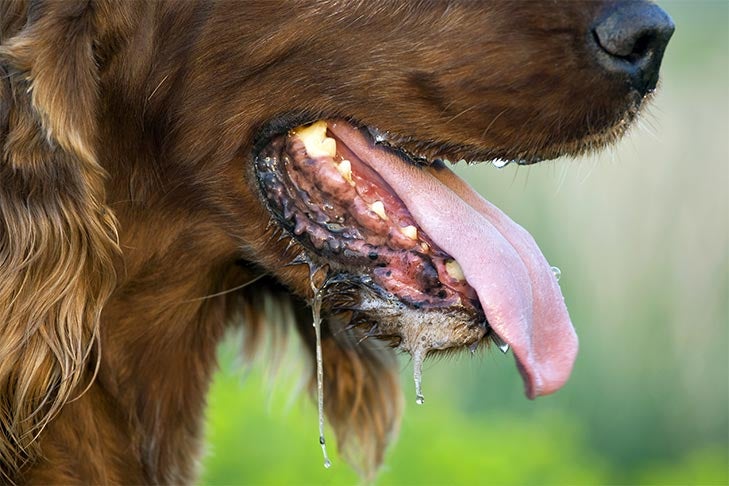If you’re worried about whether your dog can eat ice cubes, don’t sweat it. Not only can dogs eat ice cubes, but these treats can offer both stimulation and refreshment when it’s hot outside. But before running to the freezer, here are some things to know about offering these frozen bites to your dog.
Ice Cubes Are Generally Safe for Dogs
Dr. Jerry Klein, the American Kennel Club’s Chief Veterinarian, says that ice cubes pose little to no threat to dogs’ health.
Since ice cubes are simply frozen water, and they offer many benefits to many dogs. For example, if you have a teething puppy, a bowl of ice cubes can offer enrichment while also soothing discomfort. Offering ice cubes can also prevent dehydration in dogs who need encouragement to drink water. “I personally have placed ice cubes in my dogs’ water bowls when we are traveling, in an effort to encourage them to drink more water,” adds Dr. Klein.
Of course, as with giving anything to your dog, you should always supervise the activity.

Ice Cubes Can Prevent Some Life-Threatening Conditions
Dr. Klein notes that ice cubes offer many health benefits, one of which is the prevention of gastric dilation volvulus (GDV), commonly known as bloat. This life-threatening condition happens when the stomach fills with gas and then twists inside the abdomen, stopping blood flow to vital organs. There are many theories behind this condition’s cause, but drinking water quickly after exercise can be a main contributor.
But here’s some good news. “Ice cubes can actually be used to slow down the rate of ingestion of water by overly excited dogs. Offering ice cubes is a way of adjusting the rate and amount of water a dog takes in,” Dr. Klein explains. “Veterinarians even recommend offering ice cubes as a way to slowly introduce water to dogs recovering from surgeries or as a tryout after vomiting episodes associated with gastroenteritis, to see if they are able to hold fluids down.”
On a hot day, ice cubes can also prevent dogs from overheating and developing heatstroke, another possibly fatal condition. However, while ice cubes help in preventing this condition, they aren’t the solution. “Too much, too soon can cause a potentially dangerous cascading chain of events. It is better to use cool water-soaked cloths or towels, along with fans or air conditioning,” he advises. “A trip to the veterinarian is always indicated for dogs exhibiting signs of heatstroke, as some signs may develop after the event.”
Considerations When Giving a Dog Ice Cubes
Before giving your dog ice cubes, there are some things to consider:
- Your dog’s dental health. If you have a senior dog, they might have weak teeth. To avoid breakage or chipping, offer shaved ice instead. It offers the same benefits as ice cubes without putting too much strain on their teeth while chewing.
- The ice cube’s size. Consider your dog’s age, jaw size, and teeth when determining whether a cube is too big, too small, or just right. This prevents tooth fractures and choking.
- Whether your dog is already overheated. As Dr. Klein mentioned, avoid giving cold liquids or ice to a dog who may be already overheated. Instead, offer room-temperature liquids and use a fan to offer much-needed ventilation.
When housetraining a puppy or managing an adult dog’s indoor bathroom habits, it’s important to monitor their water intake. This includes accounting for water consumed through ice cubes and other frozen treats. While hydration is essential, excessive water consumption can lead to more frequent urination and potential accidents indoors.

As a general rule of thumb, your dog needs one ounce of water for every pound they weigh. So, a 15-pound puppy would need 15 ounces of water daily; that’s about 1.8 cups. Rely on your dog’s activity level, weight, and other needs when offering water in any form.
Ways to Make Ice Cubes Tastier for Your Dog
While plain ice cubes can offer a refreshing snack, you can take the concept a step further and create a delicious, nutritious treat. Some DIY frozen dog treats include freezing:
- Low-sodium chicken or beef broth
- Water infused with fruit, like watermelon
- Plain, unsweetened yogurt (if your dog isn’t lactose intolerant)
- Cucumber water
- Bone broth
- Pureed pumpkin mixed with water
- Unsweetened coconut water without additives
You can also freeze xylitol-free peanut butter and stuff it inside a hollow rubber toy, like a KONG. Frozen cantaloupe chunks in moderation can also help cool down a dog on hot, summer days.
There are also many brands of “dog ice cream” that offer the same cooling effect as ice cubes. Contrary to what the name suggests, these products usually don’t contain milk, but rather a mixture of whey, cheese, and water. When served alongside water and in combination with a balanced diet, these snacks can also offer relief on the hottest days.
Bottom Line: Ice Cubes Are a Safe, Beneficial Treat
Water, whether frozen or liquid, is necessary for a dog’s vital organs. It lubricates their joints, aids in digestion, and promotes solid brain function. It also helps to prevent dehydration and overheating – both of which can prove detrimental.
Giving your dog ice cubes is just another way to ensure your dog’s body stays hydrated and performs optimally. “Finally, ice cubes are not dangerous to dogs, per se. So, if you’re thinking about offering an ice cube … chill. It’s OK,” Dr. Klein concludes.

